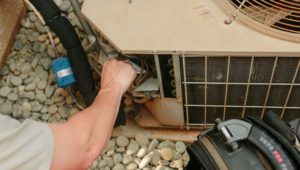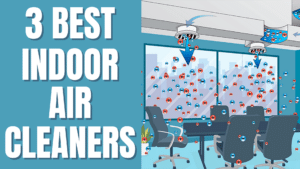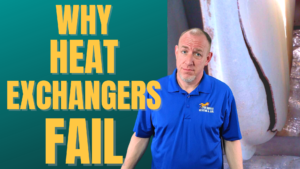In 2010 when I started my venture into the HVAC industry, I was coming in during a time of transition. Our industry was changing from systems that had R-22 refrigerant circulating through their lines to R-410a. This new refrigerant has no chlorine in it, which R-22 had. When chemicals like chlorine rise into the atmosphere in the form of an HVAC system leaking refrigerant, it damages the ozone layer. This is what we’re talking about today on Fox Family Heating & Air.
The new-new refrigerant coming very soon is R-454b, also known as Opteon XL41. It’s just funny right now. When I go into people’s homes, and they say the technician was talking about the “new” R-410 refrigerant, in my mind, I already know that 410 will be phased out very soon. Just like R-22 was phased out.
Environmentalists found the “new” R-410a has less ozone depletion potential (ODP) since it doesn’t carry chlorine in its composition. But the global warming potential (GWP) of it was still too high. In fact, the “new” R-410a’s GWP is actually higher than the old R-22!
In response to this, manufacturers have been trying to figure out a better refrigerant to use—one with no ozone depletion potential and less global warming potential. And to bring you up to speed on these gasses as they’ve changed over the last few decades — only a generation ago, the refrigerant R-12 was commonly used to cool houses before R-22 took its place. Then, R-22 was replaced by the new R-410a as recent as 2010. Now, 13 years later, R-410a is being replaced by R-32 and R-454b. All to decrease 1. ozone depletion potential and 2. global warming potential.
The goal is to get the global warming potential of refrigerants below 500. The potential of these refrigerants is:

Halons were once the holy grail of fire suppression for sensitive items like IT rooms, data centers, museums, and libraries that would otherwise be damaged by sprinkler systems. But they’re banned now and being replaced by alternative suppression systems. I give you that information as a reference to the refrigerants used in the HVAC industry. They’re not as bad, but much more refrigerant is released into the atmosphere than fire suppression halons.
Even though R-22 only has an ODP of 0.5 per metric ton, its effect on the ozone layer isn’t suitable for future generations. And like I said before, while the “new” R-410a has no ODP, it has a little higher global warming potential.
R-454b offers pressures much more similar to R-410a and requires a little bit less of a charge. R-32 was another option for use as a low GWP refrigerant, but its potential of 675 is higher than 500. A dip below 500 will likely become the industry standard soon, so it makes sense to choose R-454b now.
New Refrigerant Not Up to Residential Building Code
If we’re going to be using this refrigerant, some things will have to change. Most importantly, the residential codes that are currently in effect. Nothing in it allows for the use of A2L (mildly flammable) refrigerants to be used in residential cooling systems.
Mildly flammable refrigerants can’t be used in existing R-410a and R-22 systems. Compressors must be upgraded. Systems designed for R-454b will require less of a charge than today’s R-410a systems and will be about 5% more efficient than current refrigerants. 410a systems will need some extra protection and usage standards not used in today’s equipment. So if people think they’re just going to drop in some XL41 into 410a systems, which do operate at similar pressures, they have some more training to do.
When Will the NEW Refrigerant Be in Use?
The EPA has approved the refrigerant for use in light commercial and residential applications for new equipment. This is why the major brands are already planning for new equipment in the future to use the “new-new” refrigerant on January 1st, 2023 (which is the date the 2022 California Energy Code begins.) And if manufacturers have to start making it for California, they’re not going to keep making 410a systems AND 454b systems. Essentially, when this happens in states like California and Washington, it will happen around the rest of the country too.
New Refrigerant Training Will Be Required
AHRI and ESCO have already created classes that will teach today’s technicians all about the new-new refrigerant. NATE will also have certification testing available for technicians. Even though we’ll be using the same types of equipment to handle XL41, they must be approved for use with A2L refrigerants, which use features like fans to dissipate fumes from the electric motors. For that reason, we need training.
All of this training will cover safety, as well as requirements for proper installation and maintenance of equipment that use A2L refrigerants.
Will R-22 and R-410a Still Be Available to Use?
Will R-22 and R-410a still be available to service existing HVAC equipment? Absolutely. But some HVAC companies will use this as an opportunity to convince the unsuspecting customer that R-22 and R-410 are “illegal” to use now, and they can’t repair their existing system. It’s a common tactic I hear from customers about the “new” R-410a. And shame on the “technicians” that do that. They give the industry a bad reputation.
Warehouses will be full of perfectly legal R-22 and other alternative replacements for R-22 until at least 2030. And 410a will be available for much longer. The protocols that are in effect to stop global warming are there to phase out the production of new, virgin refrigerant. Recycled refrigerants and current inventory will be around much longer after they stop making it.
R-32, R-454b, and R-466a have been the leaders as possible replacements for the current ones because they have no ozone depletion potential and much less global warming potential. It looks like R-454b has emerged as the winner. Leading manufacturers were forced to decide which refrigerant they were going to use that was also approved by the environmental authorities.
Certification for 454-B
The residential codes that just came into effect on January 1st, 2020, are already established. Nowhere in the codes is the use of A2L, mildly flammable refrigerants, approved, so some changes will have to be made for the codes beginning January 1st, 2023, for that to happen. Training will also be made ready for the transition over to 454b, and certification might be mandatory when that happens.
Now you’re up to speed on the upcoming industry change over to the new-new refrigerant. Thanks so much for stopping by. We’ll see you on the next blog post.
Fox Family Heating & Air serves Sacramento, Rancho Cordova, and all of Northern California. If you’re looking to schedule HVAC service in these areas, give us a call!



















